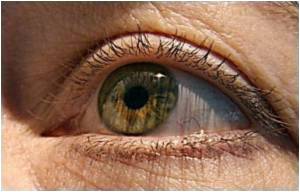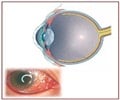Transplantation of a plastic corneal implant could restore the ability to see in patients, who have lost their sight in an accident or illness.

These can help patients who are unable to tolerate donor corneas due to the special circumstances of their disease, or whose donor corneas were likewise destroyed.
The miniscale artificial cornea has to meet almost contradictory specifications: On the one hand, the material should grow firmly together with the cells of the surrounding tissue; on the other hand, no cells should settle in the optical region of the artificial cornea - i.e., the middle - since this would again severely impair the ability to see.
In addition, the outer side of the implant must be able to moisten with tear fluids, otherwise the implant will cloud up on the anterior side. This would consequently require the patient to get a new prosthesis after a relatively brief period of time.
The outer side of the implant must be able to moisten with tear fluid, so that the eyelid can slide across it without friction.
Storsberg found the solution with a hydrophobic polymer material. This material has been in use for a long time in ophthalmology, such as for intraocular lenses.
Advertisement
The material was thoroughly modified on a polymer-chemical basis, and subsequently re-tested for public approval.
Advertisement
Then, a special protein was added that contains the specific sequence of a growth factor.
The surrounding natural cells detect this growth factor, are stimulated to propagate and populate the surface of the corneal margin.
Thus, the cells of the surrounding tissue grow with the implant, and the artificial cornea attains stability.
The eye prosthesis evolved jointly with physicians and manufacturers in the EU project, "Artificial Cornea".
The interdisciplinary research team needed three years to develop the artificial cornea.
Firstly, they sent the chemical-biomimetic coated implant to Dr. Karin Kobuch of the Poliklinik fur Augenheilkunde at the Regensburg University Medical Center and to the medical center at the Technical University of Munich.
The physician examined the artificial corneas in dissected pigs eyes and specialized cell cultures.
Eventually, researchers at University Center for Ophthalmology in Halle (Saale) tested the more complex models in rabbits.
There, the design was further refined- the optics were made smaller, and the implant haptic enlarged in order to maintain a more stable construction.
Miro GmbH manufactured the implant, robin GmbH handled the distribution and sales and supported the specially adapted implantation centers in Europe.
By 2009, a prosthesis was already successfully in use; further implantations are anticipated during the first six months of 2010.
Source-ANI
RAS











